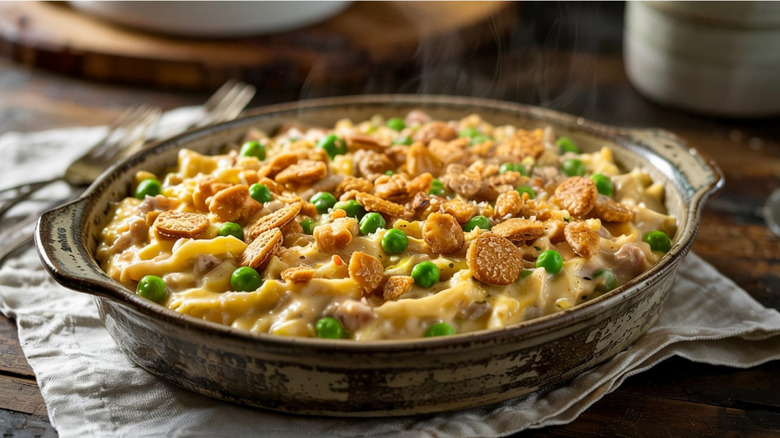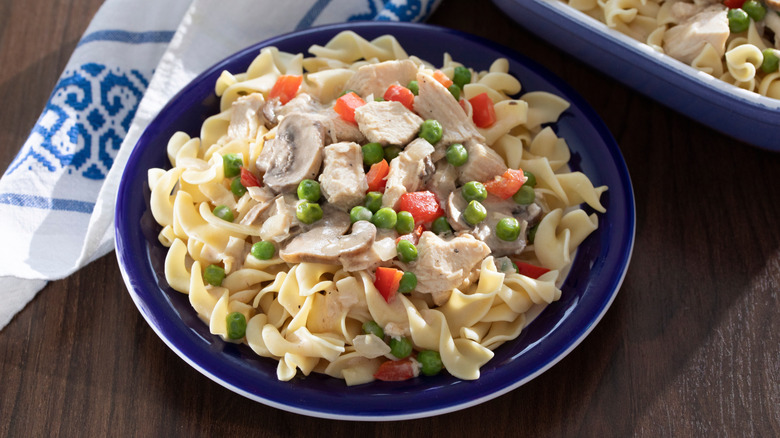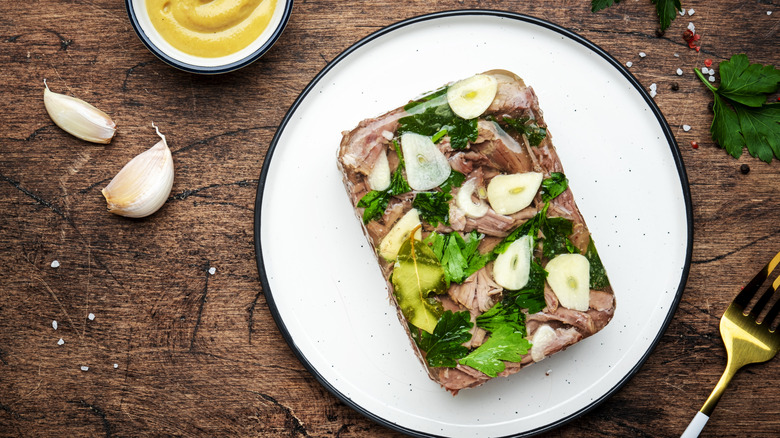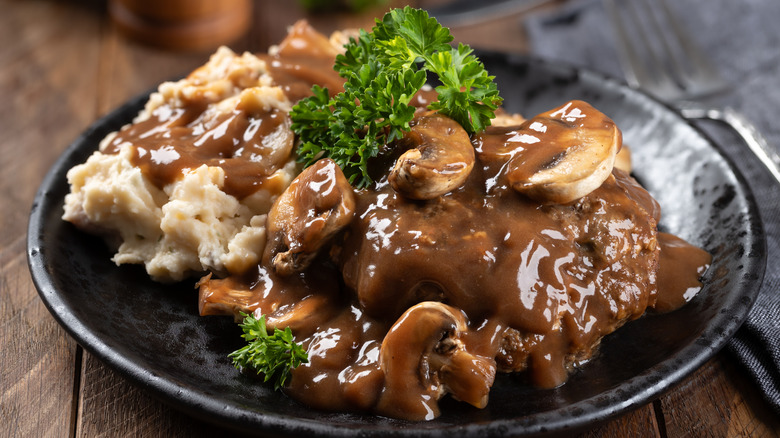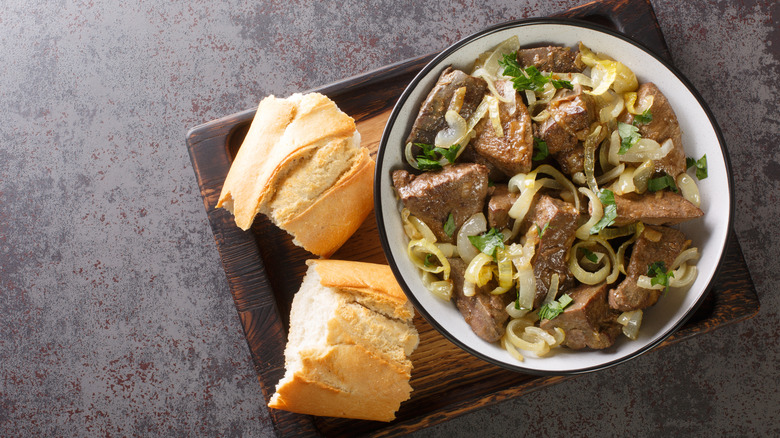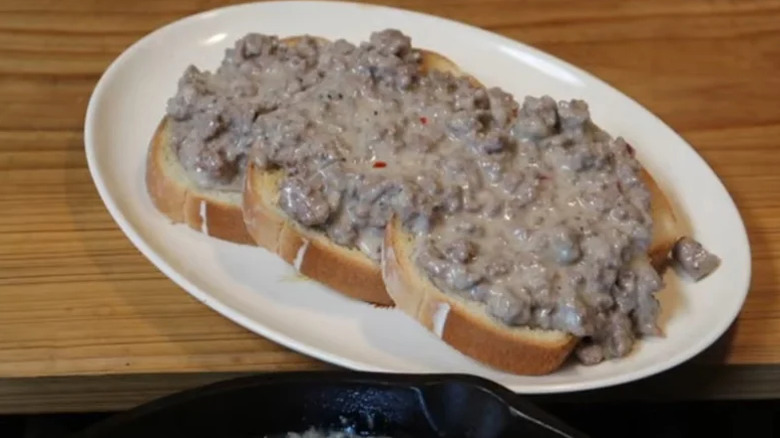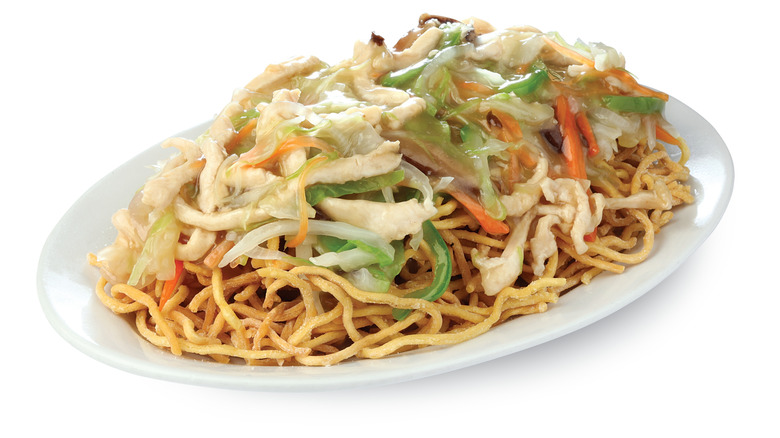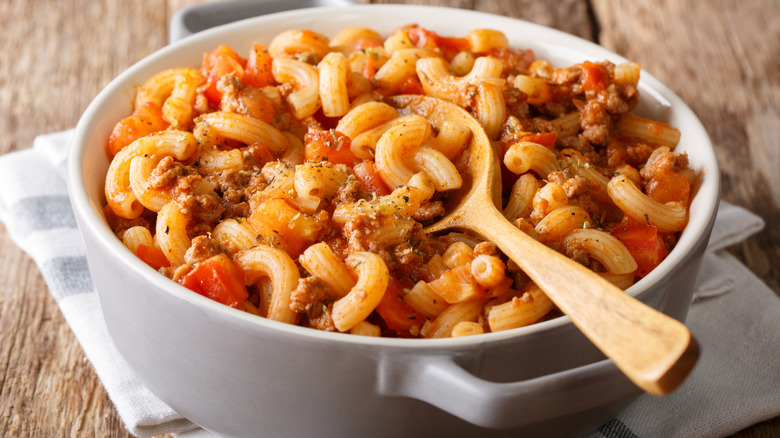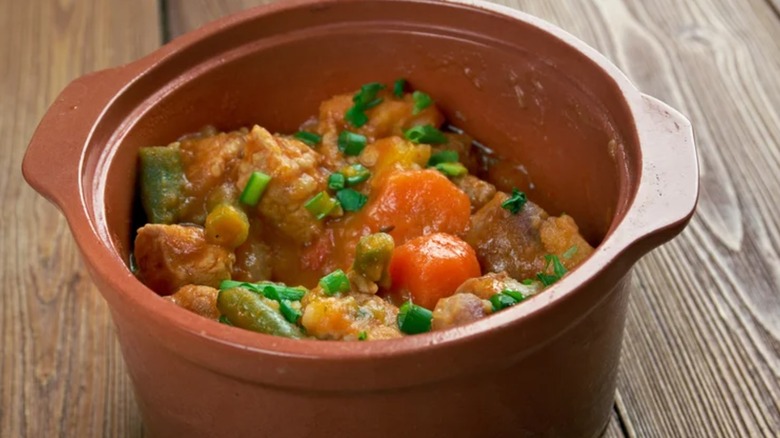Classic Sunday Dinners Your Grandparents Loved That Slowly Disappeared
Many of us have fond memories of heading to our grandparents' house for a family dinner. Family dinners took place in many households on Sundays in the mid-1900s as a day when farm families could connect (likely after church). Whether it was a huge affair full of extended cousins and great aunts or a small weekly meal with your immediate family, quality time spent with loved ones likely happens around the dining room table. Almost as memorable as the company is what exactly was being served for dinner. There was a certain cuisine at grandma and grandpa's house that was unmatched anywhere else. The menu may have varied depending on the day, but what your grandparents served likely wasn't what was being offered up at the trendy restaurants.
The cooking of earlier generations was influenced by historic events like the Great Depression and World War II. Eventually, the actual food served at the dinner table became more about convenience as preparation time became an issue. Over time, some of these classic dishes became rarer and rarer. We took a walk down memory lane to find some of the once-popular meals that may find their way back to our plates (for better or for worse).
Tuna noodle casserole
Tuna noodle casserole is known as one of the original dump-and-bake dinners. When I asked my mother-in-law about some of her favorite meals growing up, this fish dish was at the top of her list. I can remember its presence on our school cafeteria menus as late as the '90s — so this casserole has had a long run. The first recipe of tuna noodle casserole was traced back to the 1930s in the Pacific Northwest. However, it reached its ultimate popularity in the '50s thanks to Campbell's Soup taking the hard work out of creating the sauce for housewives, not to mention the cost-effectiveness of using a protein like canned tuna. Add in frozen peas and you have a complete meal with vegetables, starch, and protein.
Nowadays, you may still find a tuna noodle casserole here and there (especially at a potluck), but it certainly isn't on the weekly meal rotation like it once was. The specific reason behind it is unclear, but the sustainability aspect of canned tuna could have factored into its decline. That's not to say that you won't be served a tuna noodle casserole as an homage to comfort meals. Versions nowadays may be dressed up a notch with additions like Greek yogurt, panko breadcrumbs, or fresh herbs.
Chicken a la king
Though the origins of this classic chicken dish are up for debate, you wouldn't have to look far to find chicken a la king in a cookbook or a restaurant throughout the 20th century. Another casserole dish that lost its luster, the original chicken a la king featured shredded, diced, or minced chicken, a béchamel sauce with pimentos, sherry, mushrooms, and peppers. It was commonly served over a starch like bread or noodles. Though it sounds French, this dish's origins are rumored to be either from hotels in New York and Philadelphia, a restaurant in New York City, or a London restaurant in the late 1800s and early 1900s. It became more and more popular over the decades, hitting a pinnacle in the 1950s and 1960s and thus ending up on the dinner table at your grandparents' house for Sunday dinner.
Why did chicken a la king fall off the poultry potluck train? It's a guessing game, but you could attribute a difference in taste as it evolved from a homemade béchamel sauce to the use of the condensed soup — we all know (and love) — for a sauce shortcut. But by making the sauce from scratch, you can create a comfort dish that rivals grandma's — all while using that leftover rotisserie chicken.
Jell-O mold salads
It's pretty common knowledge that Jell-O molds were all the rage from the 1950s to the 1970s. But the Jell-O fun went beyond the fruit-laden salad served as a side dish or dessert mold topped with whipped cream. Some people from the older generations may remember the more savory concoctions thanks to the use of aspics. Aspic traveled over to the United States as early as the 19th century, but the methodology to preserve meats was used in Europe much earlier on, using other binders before gelatin was around. Eventually, the use of powdered gelatin would lead to your grandparents' generation serving a savory meat-based gelatin with tuna or salmon as the dish's star. Now Jell-O mold salads are widely regarded as "out of style" as many lean toward more natural, sustainable food options instead of the bright colors.
But not everyone fits that mold (pun intended). In the last decade, Aspic fanatics have united via social media to share their creative molds. A side dish example that can be brought back to the summer cookout could be a tomato aspic, a gelatin tomato base with celery and onions suspended throughout. If you have a crowd that loves to embrace the weird appearance and unlikely flavor profile combinations of aspics, break out your mold for a retro dish.
Salisbury steak
File this classic dish from the 1970s under the "steak" dishes that weren't necessarily steak cuts. Salisbury steak could be served at your dinner table with mashed potatoes and peas (or in a TV dinner tray in front of the TV, depending on your dining preferences). Salisbury steak is said to have been part of a high-protein diet given to soldiers in the American Civil War by Dr. James Henry Salisbury, as part of research into treating digestive issues. The popularity of Salisbury steak (named in Dr. Salisbury's honor) continued throughout World War I and World War II, into the '50s and '60s, permeating households with other similar dishes like Swiss steak and hamburger steak. Salisbury steak isn't actually a steak, per se. Instead, ground beef is prepared akin to a meatloaf with fewer ingredients and formed into a flat patty, browned in a pan, and covered with a brown mushroom and onion gravy.
Though you can still find TV dinners in the frozen food aisles of your grocery store, chances are that you aren't loading up your shopping cart with Hungry Man dinners for your family. However, your grandparents may surprise you with a homemade version for Sunday dinner that can actually be pretty tasty.
Liver and onions
You may have spotted the classic liver and onions dish on the menu in select restaurants over the years and thought to yourself, "Who would want that?" Turns out that quite a few people do, according to the regulars at the homestyle family restaurant I worked at in the early 2000s. My husband was even pleased to try out liver and onions for the first time at a diner while on a road trip out West recently. If this wasn't on your family's Sunday dinner circuit, the dish is exactly what it sounds like — liver and onions. Beef liver is commonly used in the United States, while lamb is the protein of choice in the United Kingdom. The liver is served with sauteed onions. Mashed potatoes were served on the side to absorb the sauce. Liver and onions is a dish that was once prevalent in households in the 1960s before it diminished in popularity, potentially due to challenges in sourcing quality meat over the years.
While you may cringe at the thought of liver and onions, there are some benefits to consider. Liver and onions are known to be nutritionally desirable due to liver's low calorie and high protein content. Plus, the movement of farm-to-table sourcing of meat and produce means a focus on high-quality ingredients, so liver and onions may actually be on the upswing.
Ham with canned pineapple
It's a memory many of us have at grandma's house (myself included): a giant ham on a platter topped with an artful display of pineapple rings and maraschino cherries in the middle. For whatever reason, ham and pineapple just go together. This classic dish spiked in popularity in the early 1900s thanks to the canning of pineapple by Dole. The fruit was typically canned, and sometimes even canned ham was used in a pinch instead of the spiral ham of my memories. The ham was baked in the oven, creating a delicious glaze that was the perfect combination of salty and sweet.
You likely haven't seen this dish in its full form over the years on the dinner party circuit, possibly due to the rise of businesses like Honeybaked Ham that do the work of cooking the large ham for you. However, it has inspired other creations like the controversial Hawaiian pizza that always divides the room on whether ham and pineapple belong on a pizza. If you are a ham lover, bring this iconic dish back for a retro family dinner, accompanied by a green bean casserole. And if you have extra pineapple, why not end your meal with a pineapple upside-down cake to fully embrace the mid-century culinary vibe?
Dried beef gravy on toast
This wartime dish is known by different names, including dried beef gravy on toast, or cream chipped beef on toast. Whatever your grandparents called it, this interesting dish's origins are long-standing. The recipe has been featured in Army cookbooks for more than 100 years, which is unsurprising, as it was named by American soldiers during WWII. The creamed (usually chipped) meat that was typically stewed in a white gravy was served on toast. Some substitutions included ground beef, as it was more widely available and required less preparation.
Though it started as a military dish, its popularity expanded throughout the country as an easy, quick meal that could feed a larger group. A nostalgia factor also came into play for those who fondly (or not so fondly) remember it from their youth. Nowadays, you may find it on a diner menu here and there as a breakfast item listed as "Creamed Chipped Beef Over Toast" or "Dutch frizzled beef" by the Pennsylvania Dutch. Whatever you call it, odds are that you aren't serving this dish for your Sunday dinner.
Chop suey with canned dry noodles
Chop suey is a stir-fry dish containing meat, egg, and vegetables attributed to the Chinese cuisine. But many people remember an Americanized version being served right at home by their moms. The exact origins of this dish are unclear, but it is believed that chop suey first rose to fame in the 1800s with wealthy Americans. By the 1930s, chop suey became more common at home thanks to canned vegetables and sauce sold by La Choy. Over time, the quality of the dish split off from its original roots, inspired by Chinese cuisine, to variations depending on the region where it was being served. The chop suey dishes of the '50s and '60s may have been served with the La Choy-provided crispy noodles attached to the canned vegetables. The protein was the chef's choice, with beef, pork, or chicken being typical options.
The evolution of chop suey led to more elevated recipe variations. Though you may find chop suey on Chinese food takeout menus, it likely won't be the same version that your grandparents enjoyed around their childhood dinner table. But the canned La Choy chop suey is still available in the grocery aisles today if you're inclined to give it a try, the old-fashioned way.
American goulash
Goulash is a stew that offers some flexibility in the actual making of the dish, as well as the name. Though Hungarian goulash is set in stone as a beef stew in a tomato-based sauce, the Americanized version was known by several different names depending on your household. American goulash, interchangeably called chili mac despite the slight differences, was the term in the Midwest, while other areas in the country, like New England, would call a very similar (if not identical) dish American chop suey. The variation between traditional Hungarian goulash and American goulash lies in the choice of beef and noodles. American goulash called for ground beef and elbow macaroni, while traditional Hungarian goulash typically uses cubed beef chuck and egg noodles.
However, the slight variations in ingredients when attempting a recipe for American goulash versus American chop suey versus chili mac gets a little more complicated. Your childhood chili mac recipe may have Mexican-American seasonings, the addition of beans, and more cheese, while American goulash has more Italian seasonings. Though there is much debate on the internet, the general consensus appears to be that American chop suey and American goulash are the same dishes, just different names. Whatever version of this beef and noodle stew your grandparents hold allegiance to, it likely had a permanent spot on the dinner menu circuit that just doesn't necessarily happen now. That could certainly change as households seek economical family meals like American goulash.
Mulligan stew
Though this stew was popular among early 20th-century migrant workers traveling the country on freight trains, but it was also likely a dish your grandmother made when she wanted to use up everything left in the fridge. Mulligan stew was a tomato-based soup that contained your choice of meat and vegetables (usually canned). It was particularly popular in the United States in the 1940s, though its origins can be traced back to the early 1900s. Eventually, the stew became popular within the upper-middle-class. Recipes also evolved with additions like carrots.
The stew is known for its sweetness, thanks to the large amount of ketchup. Many recipes call for an entire bottle of the condiment, so this probably isn't the dish for you if you aren't a ketchup fan. Those who grew up in the Depression era remember the stew being served with leftover pasta noodles, rice, or simply with white bread and crackers. There may not be a specific reason why Mulligan stew isn't as widely enjoyed anymore, but one can assume the availability of fresh ingredients and store-bought soup bases that don't require the use of ketchup contributed to its downfall.

